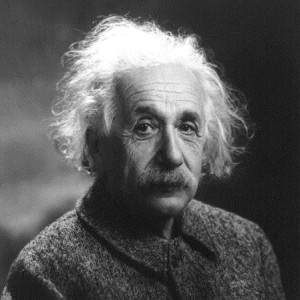Albert Einstein’s Figure in Science, Film, and Beyond
 His name has become synonymous with genius; his playful, quirky persona and shaggy image the basis for the pop culture phenomenon of the absent-minded professor, and his incandescent brilliance forever changed the world and marked him Time magazine's "Person of the Century." Yet, despite his far-reaching impact and his overwhelming popularity, Albert Einstein remains something of an enigma.
His name has become synonymous with genius; his playful, quirky persona and shaggy image the basis for the pop culture phenomenon of the absent-minded professor, and his incandescent brilliance forever changed the world and marked him Time magazine's "Person of the Century." Yet, despite his far-reaching impact and his overwhelming popularity, Albert Einstein remains something of an enigma.
The combined effects of myth-making and misunderstandings have wildly distorted our view of the real Einstein, and the span of decades has calcified this false image. It can be difficult to separate Einstein the man from Einstein the myth. As his birthday draws near, we owe it to the world's most famous genius to seek a better understanding of the man and his many remarkable accomplishments-in the world of science and beyond.
Early life
Born in Ulm, Württemberg, Germany, on March 14, 1879, Albert Einstein displayed a deep, restless inquisitiveness from an early age. After attending a Catholic elementary school until age eight, he received his advanced primary and secondary education at Luitpold Gymnasium in Munich. Despite showing signs of great intellect, Einstein's tendency toward unconventional, creative thought led him to frequently clash with the school's strict rote learning style.
At the young age of 17, Einstein enrolled in a mathematics and physics teaching diploma program at the Swiss Federal Polytechnic in Zürich, Switzerland. He graduated four years later despite rarely attending classes, preferring to study at home and work through problems in his own way. Following graduation, Einstein spent two years in search of a teaching position before accepting his now-familiar post as a technical assistant at the Bern patent office.
Scientific theories
One of the advantages of Einstein's post as a patent examiner was the generous free time it afforded him to conduct his famous thought experiments. His work paid off in an extraordinary way in 1905 when, at the age of 26, he published a series of four papers that would revolutionize the world of science. Known as Einstein's "Miracle Year," these papers covered the photoelectric effect, Brownian motion, the special theory of relativity, and the equivalence of energy and mass.
Though the latter paper spawned the most famous equation of all time, E=mc², and the special theory of relativity is also among the most famous and influential scientific works ever created, it was his work on the photoelectric effect that would ultimately earn him a Nobel Prize in Physics. Einstein's work on Brownian motion is perhaps his least well-known, but it, too, was a revolutionary insight. Drawing on mechanics, statistics and various other disciplines, Einstein provided an explanation for the seemingly random motions of particles first observed in 1827 by botanist Robert Brown.
Personal life
Despite the popular caricature of Einstein as a goofy, light-hearted genius with a taste for the eccentric, the real man was more complex. He was married twice, first to Mileva Maric, a fellow student at the Swiss Polytechnic's math and physics program, and later to Elsa Löwenthal, a first cousin with whom he'd had an affair while still married to his first wife. Though he was generally warm, welcoming, and loyal toward his friends, his philandering was well-known and he often treated both his wives with detachment. His sons, Hans and Eduard, came to feel abandoned after Einstein moved away, leaving them with their mother Mileva.
Outside of the sciences, Einstein's greatest passion was music. His mother instilled in him a love of classical composers from an early age, and he took quickly to playing the violin. He was born to non-observant Jewish parents and briefly attended the Catholic elementary school mentioned earlier, but he had little regard for a personal God. Later in his life, he became a strident advocate of civil rights and an outspoken critic of American racism and segregation. He supported the ideals of socialism, often criticized capitalism and controversially advocated a form of world government as a means for keeping individual nations in check.
Influence on pop culture
Alongside his towering influence on the sciences and the way we understand the world, Albert Einstein also had an outsized influence on pop culture both during his lifetime and in the decades since his death. His wild hair, amusing accent, and playful, avuncular demeanor still represent the blueprint for the bright but absent-minded professor. He's become a popular fixture on the big screen, being portrayed directly in films such as I.Q. and A.I.: Artificial Intelligence and also inspiring indelible characters such as Dr. Emmett Brown in the Back to the Future series.
Einstein has also been a popular subject on television, appearing perhaps most notably in two episodes of Star Trek: The Next Generation in holographic form. The historical drama Einstein and Eddington, (click here for local listings), explores Einstein's relationship with English astronomer and physicist Arthur Eddington as Eddington worked to provide observational proof for Einstein's theory of general relativity.
Whether his theories are being called to the forefront of contemporary scientific theory or serving as inspiration for one of a range of archetypal characters, Albert Einstein's presence in today's world continues to loom large. His legend, like his work, remains larger than life.

